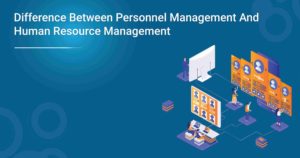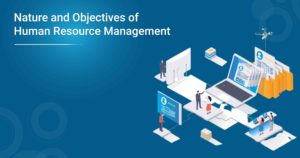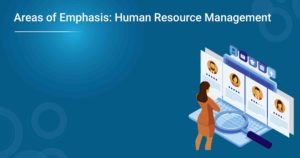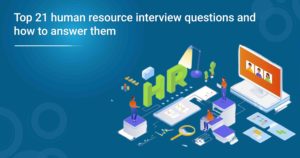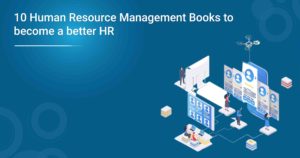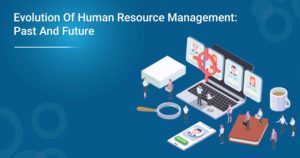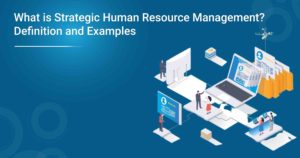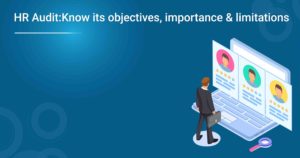Human resource is the driving force of a company, and as a result, the HR department becomes an imperative division responsible for attracting, hiring, and retaining employees. An effective HR strategy can help a company save money, time, and resources. Creating and implementing an HR strategy can be a daunting task. It’s important to remember that HR is one of the most important aspects of any business – it’s what keeps your employees optimistic and productive.
This comprehensive HR guide will walk you through the steps necessary to create and implement an HR strategy that works for your company. We’ll discuss everything from recruiting new employees to satisfying your current staff. Let’s get started!
What Is An HR Strategy And Why Is It Important?
HR strategy is a plan of action designed to achieve the HR objectives of an organisation. It has to be aligned with the business strategy to support the achievement of business goals.
An effective HR strategy will help to attract, develop and retain the best talent, which will, in turn, improve productivity and performance. A well-designed human resource strategy will also help to create a positive work environment and culture, allowing your employees to achieve the company’s objectives.
There are many benefits to creating a human resource strategy, but some of the most important ones include:
- Improved organisational performance: By aligning the HR plan with the business strategy, organisations can ensure that their HR initiatives are focused on achieving business goals leading to improved organisational performance.
- Increased employee engagement and satisfaction: An effective HR strategy will result in employees who are more engaged and satisfied with their work, paving the way for increased creativity and decreased turnover.
- Improved talent acquisition and retention: HR strategies can help you identify and attract top talent and retain your best employees. By creating a positive workplace culture and offering competitive benefits, you can encourage your employees to stick around.
- Reduced costs associated with a turnover: The HR strategy you develop should help to reduce the costs associated with turnover. When employees leave, it can cost your company money in terms of lost productivity, the need to train new employees, and more.
- Enhanced compliance with HR regulations: HR strategies can help to ensure compliance with HR regulations by ensuring that these regulations are communicated to employees and managers and by implementing processes and procedures to ensure compliance.
- Reduced HR costs: HR can be a significant expense for businesses, so it’s essential to have a strategy that will help reduce HR costs. One way to do this is to automate HR processes. By automating HR, you can reduce the time and money spent on HR tasks.
Want to relish the benefits of Human resource strategy as an HR professional? Check out our Post Graduate Certificate in Human Resource Management, where you can learn the ins and outs of HR management and more.
Also Read: What is Strategic Human Resource Management? Definition and Examples
How To Create An Effective HR Strategy For Your Company?
HR strategy is critical to the success of any business. It can be the difference between a company that flourishes and one that flounders.
Quick Checklist to Prepare An HR Strategy:
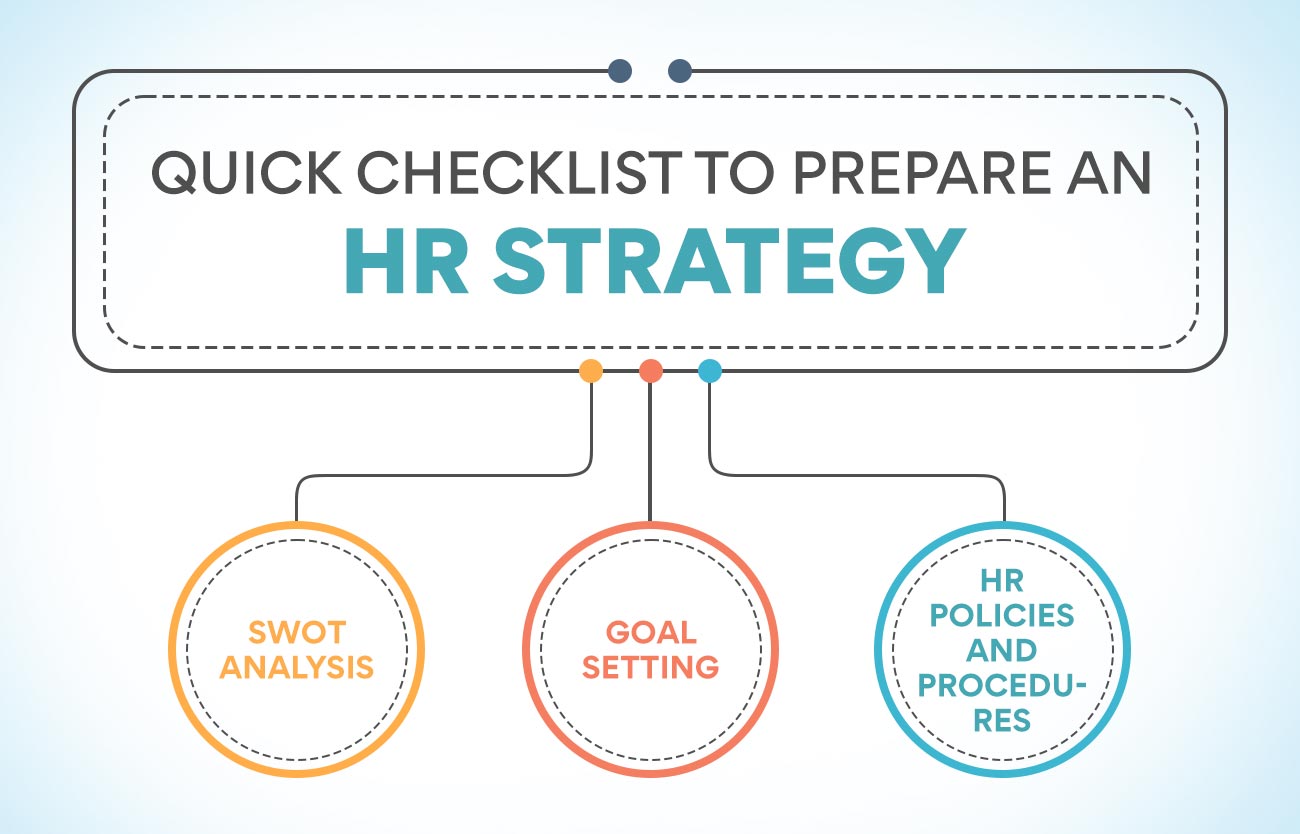
SWOT Analysis:
- It should be grounded on a stringent SWOT analysis of the company. A SWOT analysis examines the company’s strengths, weaknesses, opportunities, and threats.
- It should aim to maximise the company’s strengths and minimise its weaknesses.
- It should also aim to take advantage of opportunities and minimise threats.
Goal setting:
- It should be linked to business goals.
- It should be specific, measurable, achievable, relevant, and time-bound (SMART)
- It should align with the company’s overall business strategy
- HR goals should be reviewed and updated regularly.
HR policies and procedures:
- HR policies and procedures should support the HR strategy and business objectives.
- HR policies and procedures should be reviewed and updated regularly.
- HR policies and procedures should be communicated to all employees.
Steps To Formulate A Successful HR Strategy
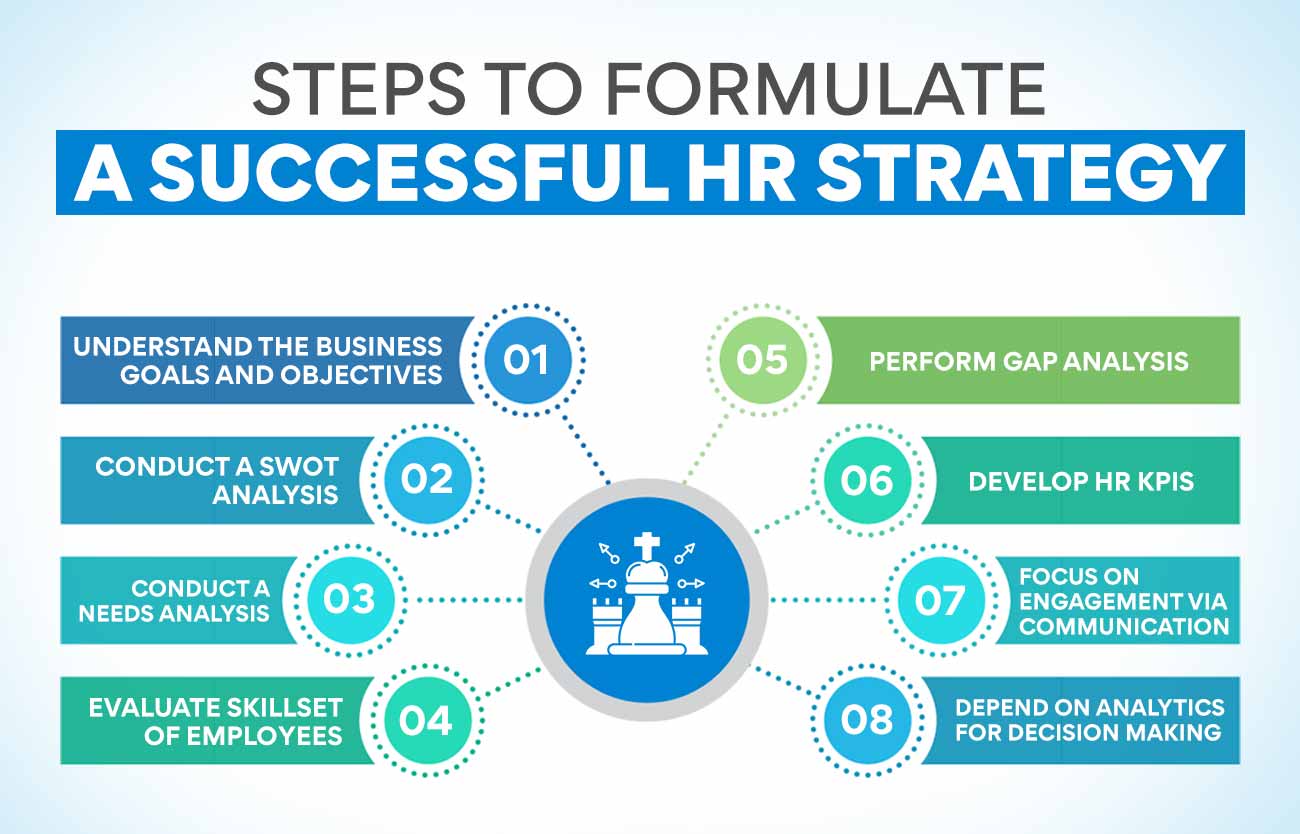
HR strategy formulation isn’t a one-time affair. It’s a continuous process that needs to be revised and updated as your company grows and transforms. Check out these steps you can take to formulate an effective HR strategy:
Understand The Business Goals And Objectives
The first step is to understand the overall business goals and objectives. You need to carve out some important objectives of the company that will serve as the foundation of the strategy.
What are the company’s overarching goals? What are the specific objectives that HR can help to achieve? Once you clearly understand the business goals, you can start aligning HR strategies accordingly.
It is imperative to comprehend all the business goals so that HR strategies can be formulated to achieve these within the given resources and a stipulated timeline. Business objectives may change over time, so HR strategies should also be reviewed and updated regularly.
Conduct A SWOT Analysis
After ascertaining the business goals, it’s time to conduct a SWOT analysis, the most crucial step in the journey that will come in handy at every stage. It will help you understand the company’s strengths, weaknesses, opportunities, and threats. You can use this information to develop a strategy to help the company achieve its goals.
Make sure to involve employees in the SWOT analysis. They likely have valuable insights you can use to develop an effective and productive strategy. Without SWOT analysis, you may create an HR strategy that doesn’t address the company’s most pressing needs.
The SWOT analysis results will help you develop HR goals aligned with the company’s overall goals. For example, if the company’s goal is to increase sales, your HR goals might be to hire more salespeople or provide training to help employees sell more effectively.
Conduct a needs analysis
Assess your company’s needs and objectives to determine HR’s role in achieving them. To do this, you must analyse your company’s HR practices, policies, and programs. You can use various methods to assess HR, including surveys, interviews, focus groups, and HR data analysis.
The human resource department can also analyse HR trends inside and outside the company to identify potential HR strategies. For example, if you’re trying to reduce employee turnover, you might research HR practices at companies with low turnover rates.
Need analysis often comes in handy in strong human resource strategy development as it provides insights into HR gaps – areas where HR can improve.
Evaluate the Skillset of Employees
HR strategy starts with evaluating the skillset of employees who can help to achieve the goals. Once you clearly understand your team’s skills and experience, you can begin developing a plan to utilise those skills best.
It may include training or development programs or simply reassigning tasks to employees who are better suited for them. Either way, it’s essential to make sure that your human resource strategy is based on your team’s specific skills and experience.
There are a few different ways to analyse the skill set of your employees. You can start by looking at job descriptions and performance reviews. It will provide a thorough overview of each employee’s skills. You can also conduct interviews and surveys to get more specific information about employees’ skills.
Perform Gap Analysis
There is no doubt that gap analysis is an integral part of human resource strategy. IT will help you understand the current state of your HR strategy, what’s working and what’s not, and where you need to make improvements. Once you have a clear picture of the gaps in your HR strategy, you can start developing a plan to close them.
Ask yourself during your gap analysis:
- What HR processes do we currently have in place?
- Are our HR processes aligned with our business goals?
- Do our HR processes support our employees in achieving their objectives?
- Do our HR processes help us attract and retain top talent?
- Do our HR processes improve employee engagement?
- Are our HR processes efficient and cost-effective?
If you find that your HR strategy is not aligned with your business goals, or if it’s not supporting your employees in achieving their objectives, it’s time to make some changes.
Develop HR KPIs
HR KPIs are the metrics that help you measure and track progress against your strategy. To develop HR KPIs, start by looking at your HR strategy and identifying the key areas you want to measure. Then, choose metrics that will accurately reflect progress in those areas. Some common HR KPIs include employee satisfaction, turnover, and training completion.
Once you have selected your HR KPIs, you need to track them regularly. You can do this manually or using HR software; if you use HR software, set up alerts, so you are notified when KPIs fall below or exceed certain thresholds.
Monitoring HR KPIs is essential to ensure your HR strategy is on track. Regularly reviewing HR KPIs can identify problems early and make necessary adjustments to keep your HR strategy on course.
Focus on Engagement Via Communication
An HR strategy should aim to increase employee engagement by improving communication. It can be done in several ways, such as:
- Encouraging two-way communication between employees and management.
- Creating channels for employee feedback and suggestions.
- Providing training and development opportunities.
- Supporting employees to share their ideas and suggestions.
By increasing communication, you can create a more engaged workforce that is more likely to be productive and motivated. It will have a significant influence on your business’s core. But it will not be a one-time event but an ongoing process that is regularly reviewed and tweaked as necessary.
Depend on Analytics For Decision Making
HR teams can improve their efficiency and effectiveness by using data to make decisions. HR professionals need to be able to justify their decisions with data. It means HR teams must become more analytical in their approach to problem-solving. HR analytics can help identify issues early on and prevent them from becoming more significant problems later.
HR teams should also use data to measure the success of their initiatives. Such information can help HR teams adjust their strategies to better meet their organisations’ needs.
HR analytics is a powerful tool to help HR teams improve performance. However, HR analytics is not a silver bullet. HR teams still need to use their determination and experience to make the best decisions for their organisations. HR analytics should be used as a supplement to, not a replacement for, human judgment.
Also Read: Breaking Down The Scope Of Human Resource Management
What Are HR Strategy Best Practices?
There’s no one-size-fits-all answer to this question – the best HR strategy for your organisation will rely on different factors, including your company’s size, industry, and HR goals. However, there are a few best practices that HR teams should keep in mind:
HR professionals must be deeply involved in the process:
HR strategy should not be developed in a vacuum – it must be created through close collaboration between HR professionals and other key stakeholders.
HR budget and even management buy-in are key imperatives in execution:
A human resource strategy cannot be successful without supporting the HR budget and management buy-in. Allocate the necessary resources upfront to avoid execution problems later on.
HR strategy must be tailored to the specific needs of the company:
Never copy another company’s strategy. What is working for one company might not be relevant for yours. HR strategy must be carefully tailored to the customised needs of your company.
HR strategy should be reviewed and updated regularly:
Like all business strategies, human resource strategy should be revised and updated to ensure that it is still relevant and not derailed from its objectives.
The Bottom Line
HR strategy is a crucial part of any business. By developing and implementing an effective HR strategy, companies can reap several benefits, including improved employee productivity, engagement, and retention.
While there is no multipurpose Human resource strategy, businesses can use the tips and advice outlined in this guide to create a tailored HR strategy that meets their specific needs and goals. With a bit of time and effort, businesses can develop an HR strategy to help them achieve their desired outcomes.
Whether you are an HR professional or aspiring to enter the human resources vertical, we have the perfect course that will skyrocket your career. Check out our Post Graduate Certificate in Human Resource Management which is the ideal roadmap toward a fulfilling and proficient career in human resources.
More Information:
Nature and Objectives of Human Resource Management
Evolution Of Human Resource Management: Past and Future
What is Strategic Human Resource Management? Definition and Examples






